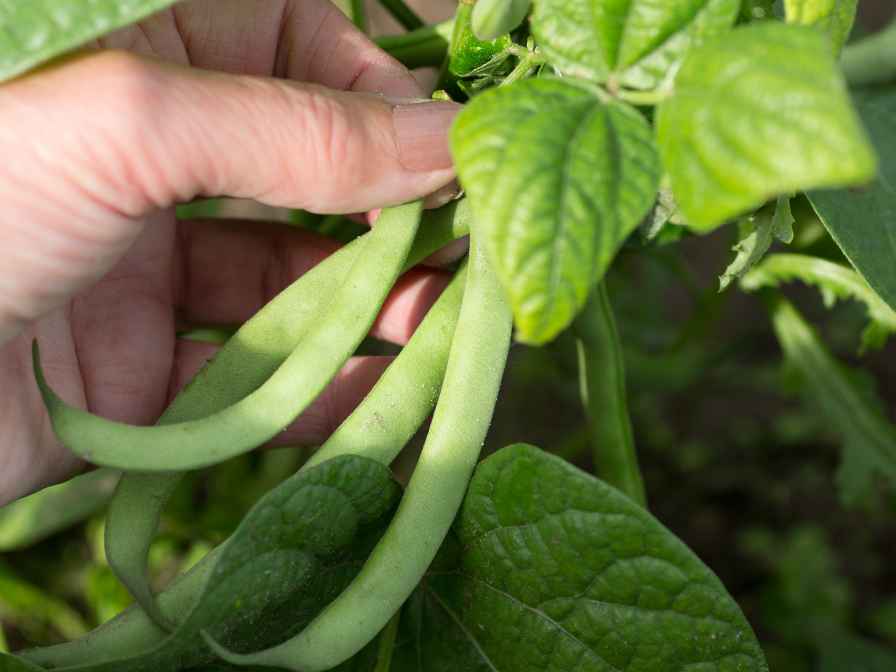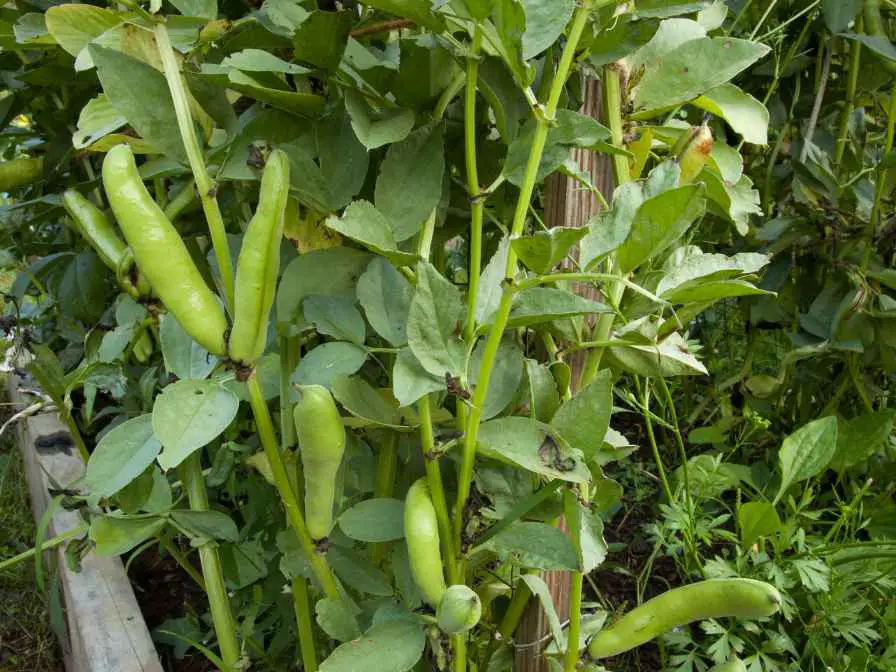Gardeners and homesteaders do like a plant in the form of fruit or vegetable which can be beneficial as a food item as well as it can be easy to grow and take care of. Well, there is one of the vegetable plants which is commonly known as navy bean plants.

Navy bean plants belong to the family of beans. It is known as navy bean because it was a staple food in the US navy. People like it for its nutritional value. That’s why we are going to tell you how to grow navy bean plants.
Navy bean Plants
Navy bean plants, also known as Phaseolus vulgaris, are a type of common bean that is widely cultivated for its edible seeds. The navy bean plant is an annual plant that can grow up to 60 cm tall and produces white flowers that develop into long, green pods. The pods contain small, oval-shaped seeds that are commonly used in soups, stews, and other dishes.
Navy beans are a good protein, fiber, and another nutrient source. They are also low in fat and calories, making them a healthy addition to a balanced diet. In addition to their nutritional value, navy beans are also used in traditional medicine to treat a variety of health problems. It includes many health problems like digestive problems, high blood pressure, diabetes, and others. Benefits of planting navy bean plants
There are many benefits of planting navy bean plants. These benefits are not only limited to the nutritious benefits but also environmental and sustainability benefits. Here are some of the important ones as follows:
Nutritional benefits
Navy beans are a good source of protein, fiber, and other nutrients such as iron, magnesium, and folate. By planting navy bean plants, you can have a fresh and healthy source of these nutrients in your garden.
Sustainability
Growing your navy bean plants can help reduce the carbon footprint. It is because it reduces the distance of food reaching the table. Additionally, navy beans are a legume, which means they can fix nitrogen in the soil. This can improve soil health and reduce the need for synthetic fertilizers.
Cost-effective
Navy bean plants are relatively easy to grow and maintain, and the seeds are often inexpensive. This can make growing your navy beans a cost-effective way to add a healthy and versatile ingredient to your meals.
Educational benefits
Planting navy bean plants can be a fun and educational activity for children and adults alike. It can teach valuable lessons about plant growth, environmental sustainability, and healthy eating. This plant grows at such a pace that it can be observed growing and fruiting as well.
Culinary benefits
Navy beans can be used in many dishes, which include salads, stews, soups, dips, and other dishes. By planting your navy bean plants, you can experiment with different recipes and enjoy the delicious taste of fresh, homegrown navy beans.
These are the main benefits due to which these beans are quite preferred. Many people use them as the best and better alternative to peas as these are pea-sized beans.
How to Grow Navy Bean Plants?
Growing navy bean plants is not such a difficult thing to do. Rather these are easy plants to grow and prosper. You just have to follow some of the basic steps which are commonly followed in the process of plantation of plants. Here are steps to follow to grow navy bean plants:
Choosing the right location
Navy beans prefer a sunny location with well-drained soil. Choose an area in the garden that gets a minimum of six hours of sunlight in a day and has good drainage. Good drainage will provide the required water and full exposure to sunlight will help it grow well.
Preparing the soil
Navy beans grow best in soil that is rich in organic matter. Before planting, add compost or well-rotted manure to the soil to improve its fertility and texture. This will help in fulfilling the nutrient requirement for the navy bean plants.
The navy bean plants do well in good and fertile soil. But they can do well in moderate soil also because the navy bean plants can fix nitrogen in the soil as well.
Plant the seeds
Plant navy bean seeds directly in the soil after the danger of frost has passed. Make small holes in the soil with your finger, about 1-2 inches deep and 4-6 inches apart. Place one seed in each hole and cover it with soil.
The navy bean plants also do well with the process of transplantation, but commonly the navy beans are sown through the process of sowing seeds directly to the soil and growing it forward.
Watering it regularly
Navy beans require consistent moisture to grow properly. Water the plants regularly, keeping the soil moist but not waterlogged. Be careful not to overwater, as this can cause the seeds to rot. As we all know excess of everything is bad.
Support the Plants
As the navy bean plants grow, they may need support to prevent them from falling over. You can use stakes or trellises to support the plants or plant them near a fence or wall for support. This support of navy bean plants will also help in avoiding the loss of yield of beans.
Taking Care of Navy Bean Plants

Taking care of navy bean plants involves several important steps to ensure that they grow healthy and produce a good crop. It is not that difficult to do. Here are some tips for caring for navy bean plants:
Watering Navy Bean Plants
The navy bean plants usually grow like other bean plants, which require a constant supply of water to keep up with the moisture. Don’t go for the excess water. It can destroy the plant or it can cause root rot. You can check the water requirement by scratching the upper layer of the plant soil.
Fertilizing requirements
Navy beans are nitrogen-fixing plants, which means they do not require a lot of additional nitrogen in the soil. However, adding compost or well-rotted manure to the soil before planting can provide the plants with additional nutrients.
Mulching navy beans
Adding a layer of mulch around the base of the plants can help to conserve moisture and suppress weeds. Use organic materials such as straw, grass clippings, or leaves for the best results. This will not only keep the moisture intact but can also provide some nutrients to the plant
Pest and disease control
Navy beans can be vulnerable to pests and diseases such as aphids, spider mites, and fungal infections. Regularly inspect the plants for signs of damage or disease and take appropriate measures to control pests and diseases.
You can keep eye on the color of leaves, and you can also keep eye on the pests. If you see any unusual symptoms you can consult with the local horticulturist as some pests or diseases can be area or climate-specific.
Harvesting and Storing Navy Beans
Harvesting and storing navy beans involves several important steps to ensure that the beans are properly dried and preserved. Otherwise, you can end up ruining the entire yield. Here are some tips for harvesting and storing navy beans:
Harvesting Navy Beans
Navy beans will be ready to harvest in 70-90 days after planting. The pods will turn yellow or brown and become dry and brittle when they are ready. Pick the pods carefully and remove the beans inside. Do it carefully so that you might not damage the beans.
Drying Navy Beans
After harvesting, spread the beans out on a clean, dry surface and allow them to dry completely. This can take several days to a week, depending on the humidity and temperature in your area. Try to dry it in the shade.
Shelling Navy Beans
Once the beans are completely dry, remove them from the pods. You can do this by hand, or by using a machine such as a bean Sheller. It will get you the navy beans you want.
Cleaning navy beans
After shelling, remove any debris or foreign material from the beans, such as leaves or twigs. Do check for the damaged navy beans. You can remove also remove them if you want. You can use them immediately.
Storing navy beans
Store the dried and cleaned navy beans in a cool, dry place, such as a pantry or cellar. Use airtight containers such as jars or plastic bags to keep out moisture and pests. Navy beans can be stored for several months if properly dried and stored. You can enjoy these beans for a longer period.
In short, navy beans can be grown with little to moderate effort. These are beans that if you plant these beans on the right time, at the right place, and proper minimum care is granted. You will be able to get a good yield from navy bean plants.

